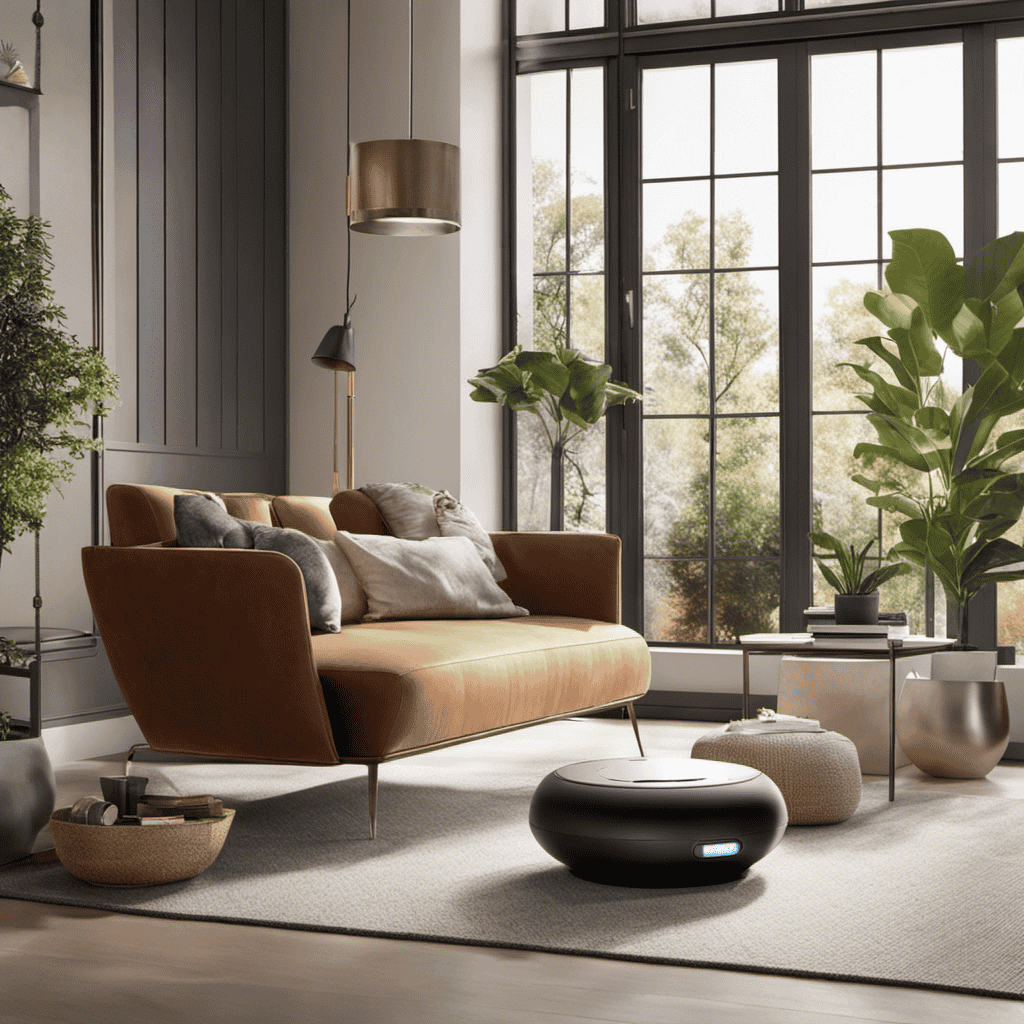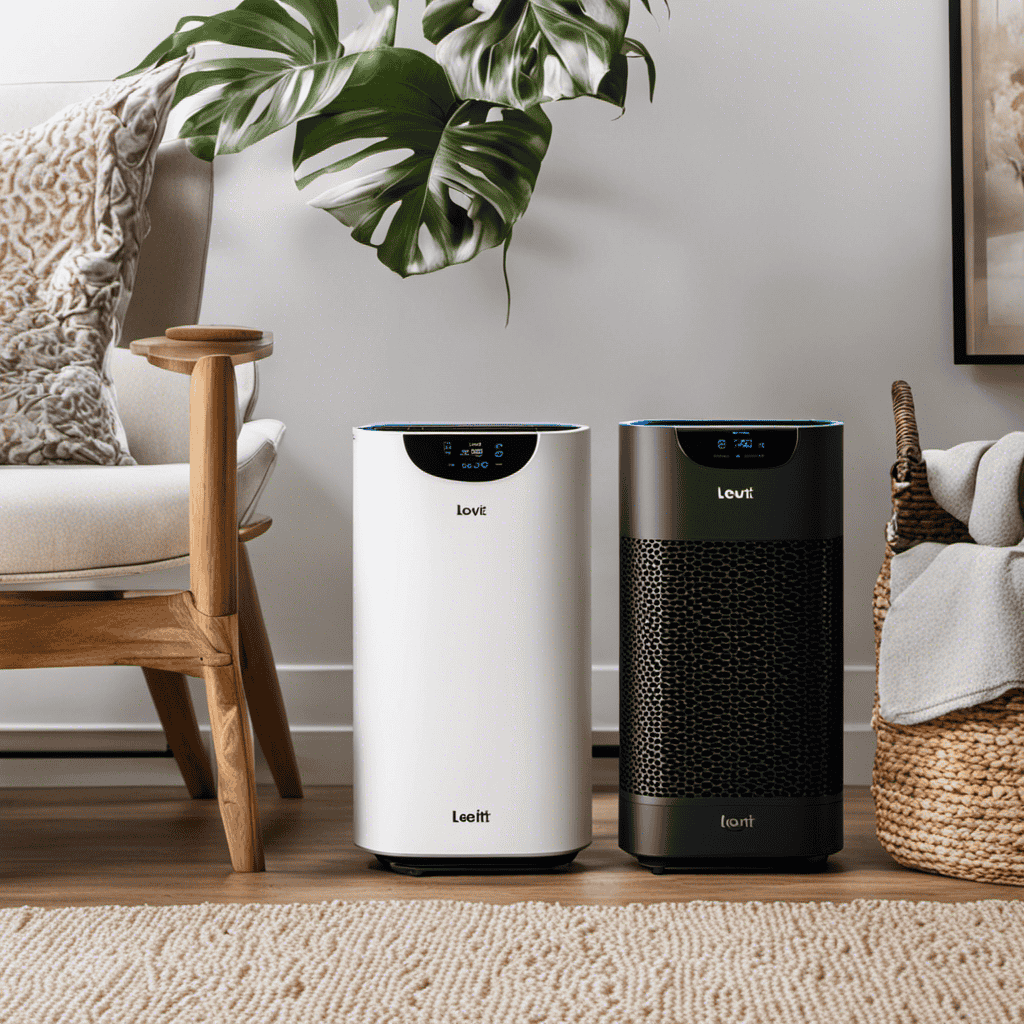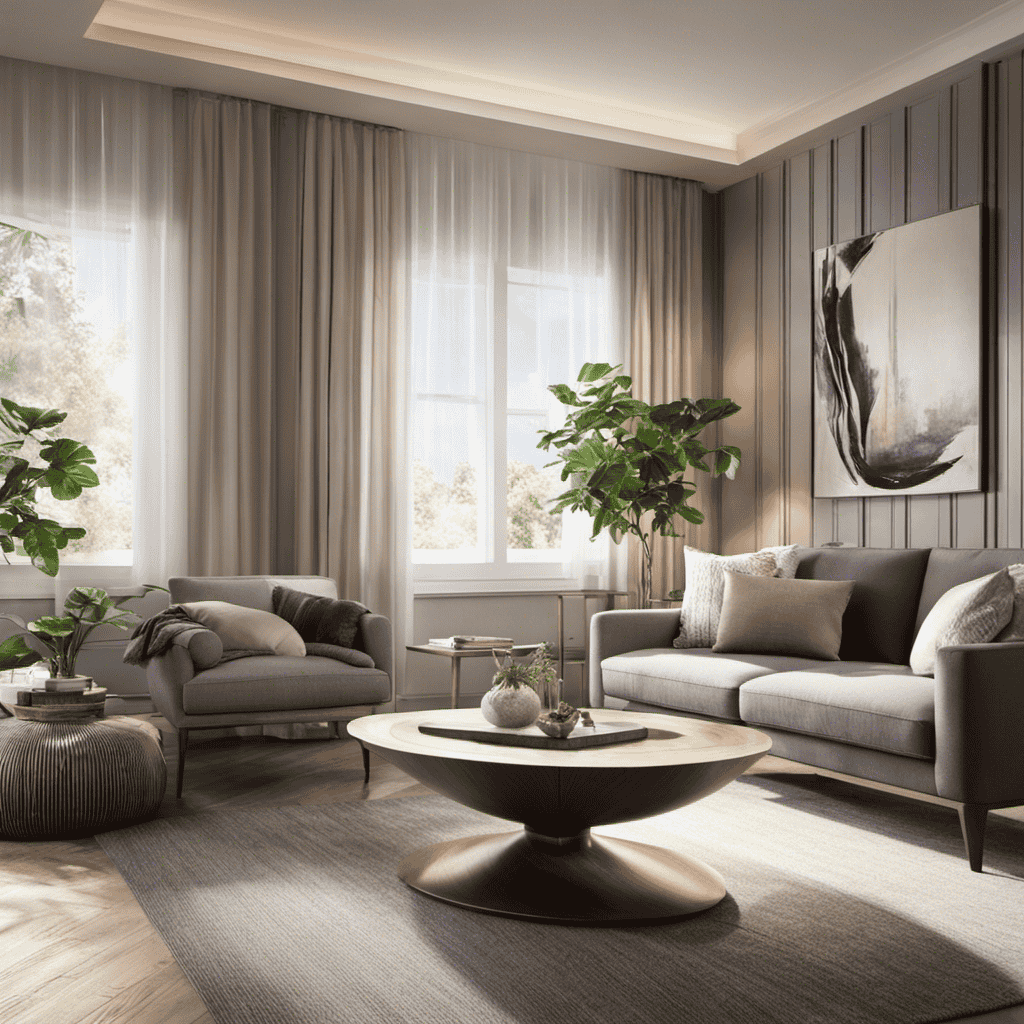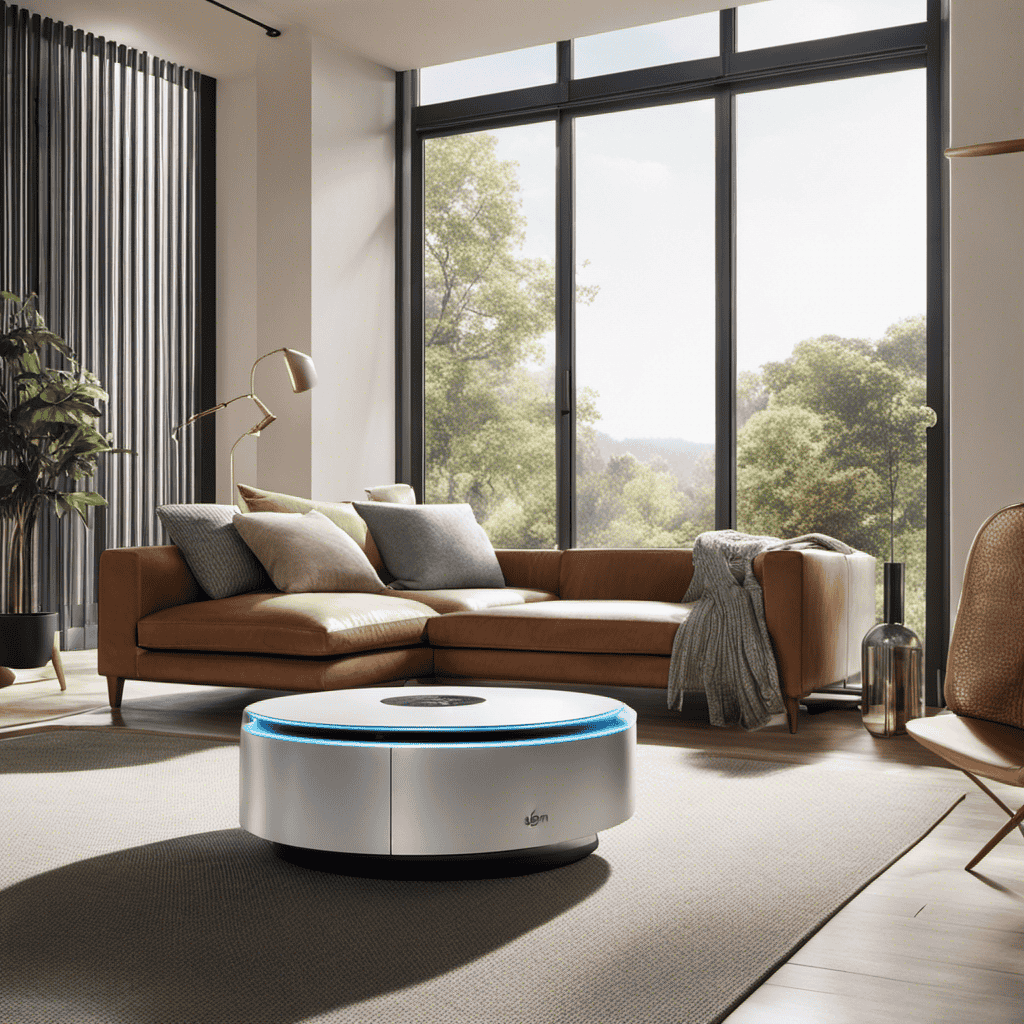Hello, fellow allergy sufferers!
Looking for the perfect air purifier to tackle those pesky cat allergies? Well, you’ve come to the right place.
In this article, I’m going to break down the different types of purifiers, key features to keep an eye out for, and why HEPA filters are a game-changer.
We’ll even compare brands and give you some tips for using your purifier effectively.
So sit back, relax, and get ready to breathe easier with the best air purifier for cat allergies.
Key Takeaways
- HEPA filters are highly recommended for capturing and removing small particles, including cat dander.
- Activated carbon filters are effective at trapping odors associated with cat allergens.
- Air purifiers with ionizers or UV-C light technology claim to neutralize allergens, but their effectiveness is still debated.
- It is important to consider air purifiers with HEPA filters and activated carbon filters for effective cat allergy relief.
Different Types of Air Purifiers for Cat Allergies
There are various types of air purifiers that can help with cat allergies. When it comes to air purifier effectiveness, it’s important to consider the specific needs of individuals with cat allergies.
HEPA (High-Efficiency Particulate Air) filters are highly recommended for their ability to capture and remove small particles, including cat dander, from the air. These filters have been proven to be highly effective in reducing allergens and improving indoor air quality.
Additionally, some air purifiers use activated carbon filters, which are excellent at trapping odors that may be associated with cat allergens.
Other types of air purifiers, such as those with ionizers or UV-C light technology, claim to improve air quality by neutralizing allergens. However, the effectiveness of these technologies in removing cat allergens is still debated.
Therefore, it is important to consider the benefits of air purifiers with HEPA filters and activated carbon filters when looking for an effective solution to cat allergies.
Key Features to Look for in an Air Purifier for Cat Allergies
When choosing an air purifier for cat allergies, it’s important to consider key features that can help alleviate symptoms. Here are four important features to look for:
-
HEPA Filter: A high-efficiency particulate air (HEPA) filter is essential for trapping allergens like cat dander and hair. It can remove up to 99.97% of particles as small as 0.3 microns.
-
Activated Carbon Filter: This filter helps eliminate odors caused by cat urine, feces, and saliva. It also captures volatile organic compounds (VOCs) that can trigger allergies.
-
Air Change Rate: Look for an air purifier that can cycle the air in a room multiple times per hour. This ensures continuous removal of allergens and maintains clean air.
-
Coverage Area: Consider the size of the room where the air purifier will be used. Choose a model that can effectively clean the air in that specific area.
Common misconceptions about air purifiers for cat allergies include thinking that they can completely eliminate allergies or that any air purifier will work. However, the benefits of using an air purifier for cat allergies in different areas of the home are significant. They can reduce allergens in the living room, bedroom, or even a home office.
Understanding HEPA filters and their importance for cat allergies is crucial, as they are the most effective filter type for capturing cat allergens.
Understanding HEPA Filters and Their Importance for Cat Allergies
Understanding the importance of HEPA filters is crucial for managing allergies caused by cats. HEPA filters, or High Efficiency Particulate Air filters, are designed to capture and trap tiny particles, such as pet dander, that can trigger allergic reactions. These filters are highly effective in reducing the amount of airborne allergens in your home, providing relief for those with cat allergies.
HEPA filters have been proven to remove up to 99.97% of airborne particles as small as 0.3 microns in size. By using an air purifier with a HEPA filter, you can significantly reduce the amount of pet dander in your indoor environment, creating a cleaner and healthier living space.
Investing in an air purifier with a HEPA filter is a wise choice for anyone suffering from cat allergies, as it can greatly improve their quality of life.
The Role of Activated Carbon Filters in Cat Allergy Relief
Activated carbon filters are effective in reducing odors and removing harmful chemicals from the air, providing additional relief for those with cat allergies. They work by adsorbing volatile organic compounds (VOCs) and other airborne pollutants.
Here’s why activated carbon filters are beneficial:
-
Odor elimination: Activated carbon filters excel at trapping and neutralizing unpleasant smells, including those caused by cat dander and urine.
-
Chemical removal: These filters can effectively capture and remove harmful chemicals like formaldehyde, benzene, and ammonia, which are commonly found in household products and can trigger allergic reactions.
-
Complementary to HEPA filters: While HEPA filters are essential for capturing allergens like cat dander, activated carbon filters provide an additional layer of protection by addressing odor and chemical concerns.
-
Effective for other allergies: Activated carbon filters are not exclusive to cat allergies. They can also reduce symptoms caused by other allergens, such as pollen, dust mites, and pet dander from other animals.
Comparing Air Purifier Brands for Cat Allergies
When looking for an air purifier to alleviate cat allergies, there are several key factors to consider.
One important aspect is the filter effectiveness ratings, which determine how well the purifier can capture cat allergens.
Noise level comparisons are also crucial, as a loud purifier can be disruptive and annoying.
Filter Effectiveness Ratings
To find the best air purifier for cat allergies, you should consider the filter effectiveness ratings. These ratings indicate how well the purifier can remove cat allergens from the air. Here are some key points to keep in mind:
-
High-efficiency particulate air (HEPA) filters: These filters are considered the gold standard in air purification technology. They can capture 99.97% of particles as small as 0.3 microns, including cat allergens.
-
Activated carbon filters: These filters are effective in removing odors and volatile organic compounds (VOCs) associated with cat allergens. They work by adsorbing these substances onto their porous surface.
-
Pre-filters: These filters capture larger particles like pet hair and dander, extending the lifespan of the main filter.
-
Ionizers: Some air purifiers come with built-in ionizers that release negatively charged ions to attract and neutralize airborne allergens. This can further enhance the purification process.
Considering these filter effectiveness ratings will help you choose an air purifier that effectively eliminates cat allergens from your indoor environment.
Now, let’s move on to comparing the noise levels of different air purifiers.
Noise Level Comparisons
If you’re concerned about noise levels, you’ll want to compare the different air purifiers. Silent operation is an important factor to consider when finding the best air purifier for cat allergies. No one wants a loud appliance disrupting their daily activities or interfering with their sleep.
Look for air purifiers that are specifically designed to operate quietly, ensuring a peaceful environment while effectively removing allergens from the air. In addition to silent operation, it’s also crucial to consider the energy efficiency of the air purifier. Energy-efficient models not only help you save on electricity bills but also contribute to a greener and more sustainable lifestyle.
Cost and Maintenance Considerations
Consider the cost and maintenance requirements of different models before making a decision. When choosing an air purifier, it’s important to take into account the long-term cost comparisons and maintenance frequency and requirements. Here are four key factors to consider:
-
Initial Cost: Compare the prices of different models and consider how they fit within your budget. Keep in mind that higher-priced models may have additional features or better filtration capabilities.
-
Filter Replacement: Check how often the filters need to be replaced and the associated costs. Some models have filters that need to be replaced more frequently, which can add up over time.
-
Energy Consumption: Look for air purifiers that are energy-efficient to keep operating costs low in the long run.
-
Maintenance Requirements: Consider the time and effort required to clean and maintain the air purifier. Some models may have more complex maintenance procedures than others.
Important Considerations for Choosing the Right Size Air Purifier
When choosing the right size air purifier for cat allergies, it’s essential to consider the square footage of the room. The size of the room will determine the capacity and effectiveness of the air purifier in removing allergens. To make an informed decision, look for the CADR (Clean Air Delivery Rate) rating on the air purifier. This rating indicates the volume of clean air the purifier can deliver per minute. A higher CADR rating is recommended for larger rooms, while smaller rooms can benefit from a lower rating.
Maintenance is crucial to ensure the air purifier continues to effectively remove cat allergens from the air. Regularly replacing the filters is essential, as they trap and contain the allergens. Check the manufacturer’s instructions for the recommended filter replacement schedule. Additionally, proper cleaning techniques should be followed, such as wiping down the exterior and cleaning the internal components.
These maintenance tips will help ensure the air purifier works optimally in minimizing cat allergies.
Tips for Using an Air Purifier Effectively to Reduce Cat Allergies
To effectively reduce cat allergies, make sure you regularly clean and replace the filters in your air purifier. This is crucial in ensuring that the purifier is able to effectively capture and remove the allergens present in the air.
Here are some tips for using an air purifier effectively to reduce cat allergies:
-
Air purifier placement for optimal cat allergy relief: Place the purifier in the rooms where you spend the most time, such as the bedroom or living room. This will help to continuously filter the air in these areas and reduce allergens.
-
Regularly clean the exterior of the air purifier: Dust and other particles can accumulate on the surface of the purifier, diminishing its effectiveness. Use a soft cloth or brush to gently clean the exterior of the purifier.
-
Clean or replace the filters as recommended: Check the manufacturer’s instructions to determine how often the filters need to be cleaned or replaced. This is important to maintain the purifier’s efficiency in capturing cat allergens.
-
Keep windows and doors closed: To maximize the effectiveness of the air purifier, it is important to minimize the introduction of new allergens. Keeping windows and doors closed will help prevent outdoor allergens from entering the indoor space.
Real Customer Reviews: Top Air Purifiers for Cat Allergies
Check out these real customer reviews to find the top air purifiers that effectively reduce allergies caused by cats.
When it comes to tackling cat allergies, it’s important to choose an air purifier with the right type of filter. The most effective filters for cat allergies are HEPA filters, which can capture even the smallest particles like cat dander and allergens. These filters work by trapping the allergens and preventing them from circulating in the air.
Another option is activated carbon filters, which can help remove odors associated with cats.
Air purifiers not only reduce cat allergies but also provide benefits for overall air quality. They can remove other allergens, pollutants, and even viruses from the air, creating a cleaner and healthier environment.
Frequently Asked Questions
Are Air Purifiers the Only Solution for Cat Allergies?
Air purifiers can be effective in reducing cat allergens, but they’re not the only solution. Alternative treatments such as medication, allergen immunotherapy, and managing cat allergies through cleaning and minimizing exposure can also help.
Can Air Purifiers Completely Eliminate Cat Allergens in a Home?
Air purifiers alone cannot completely eliminate cat allergens in a home. While they can reduce allergens, alternative remedies like keeping cats out of bedrooms and regular cleaning are also important.
How Often Should I Change the Filters in an Air Purifier for Cat Allergies?
When it comes to changing the filters in an air purifier for cat allergies, it’s important to do so regularly. The frequency can vary depending on the model, but generally, it’s recommended to change them every 3-6 months for optimal performance.
Can Air Purifiers Help With Other Types of Allergies or Respiratory Conditions?
Air purifiers are beneficial for various allergies and respiratory conditions. Studies show that they can effectively remove pet dander from the air, making them ideal for cat allergies. Additionally, they provide relief for asthma sufferers by reducing asthma triggers.
Are There Any Potential Side Effects or Risks Associated With Using Air Purifiers for Cat Allergies?
There are potential side effects and risks associated with using air purifiers for cat allergies. It’s important to consider effective alternatives and weigh the benefits against any potential drawbacks.
Conclusion
In conclusion, when it comes to finding the best air purifier for cat allergies, it is crucial to consider key features such as HEPA filters and activated carbon filters. These filters play a vital role in capturing and eliminating cat allergens from the air, providing much-needed relief for allergy sufferers.
According to a study conducted by the American Academy of Allergy, Asthma & Immunology, using an air purifier can reduce the concentration of cat allergens in the air by up to 90%. This statistic highlights the effectiveness of air purifiers in combating cat allergies and emphasizes their importance for those seeking relief from allergic reactions.
By choosing the right size air purifier and using it effectively, allergy sufferers can significantly improve their indoor air quality and enjoy a cat-friendly environment.










